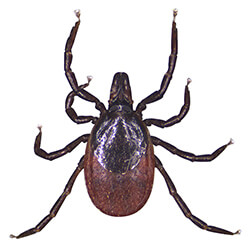Ticks
What's a tick ?
 Ticks are external parasites that feed on blood sucked from humans or animals.
Ticks are external parasites that feed on blood sucked from humans or animals.
Ticks generally live in wooded or forested areas, grass, bushes, undergrowth, meadows and clearings, but can also be found anywhere there is grass (along wildlife paths, lawns, parks…).
Ticks do not jump or fly but crawl slowly.
They drop from blades of grass or twigs onto a host.
Ticks require blood to survive and reproduce.
Ticks embed themselves in their host in areas where the skin is thin (the back of the knee, the armpit, the groin) by inserting their rostrums in the skin.
They secrete substances through their saliva glands which allow them to anchor themselves solidly in order to suck blood.


Ticks on dogs and cats
You may find ticks anywhere on your dog or your cat even if you medicated your pet with a chemical product.
Ticks are most often found around the head. Indeed, dogs and cats first touch vegetation with their heads.
Ticks attached to dogs and cats are usually big, because we find them late due to the animal’s hair or fur : The large TICK TWISTER® hook is therefore the most appropriate.
Nevertheless, for hard-to-reach areas (ears for example) or for long haired pets, the small TICK TWISTER® hook may be better.

Ticks on human
People who are involved in forestry , and wildlife occupations (such as loggers, trappers,...), or who are active outdoors (campers, hikers, hunters, anglers...) are exposed to tick bites..
On humans, ticks’ favourite locations are thin skin areas (armpits, the upper thigh, the groin, behind the ears) but can also be found in other areas (e.g. arms...).
Sometimes ticks are so small (under 1/2 mm) that you can hardly see them.
But after 24 hours an itchy red spot generally develops around them.

Ticks on horses
Horses living in stabels have little or no contact with wildlife or vegetation; they can however be subject to tick bites while out riding ; a complete check-up is necessary after each ride..
While grazing horses are are frequently subjected to tick bites ; In this case, a complete check-up is necessary every day.
On horses, ticks’ favourite locations are thin skin areas (the pit of the leg, the groin area and upper thigh, and the anus) and those in contact with vegetation (the legs, the neck and the throat).
Spraying chemical products on horses has little effect. Horses sweat, so chemical barriers do not last long enough to be effective, especially in warm weather or if the horse is working.
In addition, many horses have allergic reactions to insecticides and chemicals.
Therefore, horse riders should always have TICK TWISTER® when riding !
Be careful - Very important
After removing the tick, if the red spot persists longer than 3 days, or grows bigger, consult your doctor immediately.
As ticks attached to humans are usually tiny, the smaller TICK TWISTER® hook is more appropriate.
